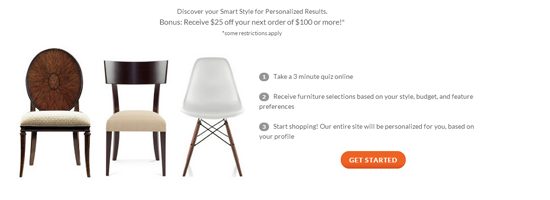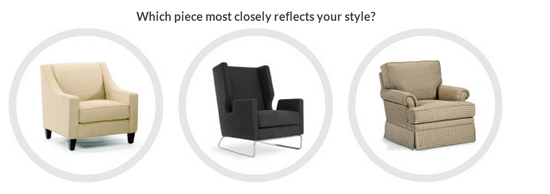Now That's Smart Web Design

When companies are founded on the idea of improving a shopping experience through what's best about the Internet and technology - some really smart things can happen.
Take Smart Furniture as the example. Its story has all the elements of a Palo Alto startup (e.g. starting in a garage) and today, its website follows and molds digital best practices, particularly in personalization.
Smart Furniture realized pretty quickly in its company's history that furniture is a very subjective category, meaning, according to Smart Furniture CEO and President T.J. Gentle, that customers can go online and know within a few seconds whether they like it or not. Enter prescriptive personalization.
The thought for prescriptive personalization was similar to most personalization efforts - making sure the right content/product goes to the right person at the right time - but the execution was something many companies overlook. Smart Furniture looked at all the ways it could determine a user's preferences (e.g. traditional furniture or modern furniture, did they live in a big house or a small condo) and that led the Smart Furniture team to the idea of simply asking the customer, which is where SmartProfile started. It's essentially a three-minute quiz that asks questions about style preferences, space availability and more.

What Smart Furniture is able to do is completely personalize the rest of the site based on the questions that a user answers.

"Since we launched that we realized we were on to something," said Gentle. "Once they went through SmartProfile quiz, they were 20 times more likely buy from us."
Smart Furniture started expanding this "quiz" to look at big data practices as well, using the information it already had (e.g. referring site, filtering selections, etc.) to create profiles based on pure data points. If a visitor doesn't sign up for the site, these profiles may never be attached to an email, but the user's cookie will remember the profile that is fine-tuned with each action the user takes - to ensure personalization on each visit.
The only problem with these personalization efforts, however, is that it put optimizing the site for different devices on the backburner.
"Sometimes you can drink your own Kool-Aid and you put all your effort into that - all of our best minds were on expanding SmartProfile," said Gentle. "At the end of the year last year, we looked at performance and had a strong growth but realized we had some real gaps and dug deeper."
What Smart Furniture found was that in 2013 the world changed dramatically in ecommerce because people started to use mobile and tablet devices to shop for and research products online. Gentle thought Smart Furniture was somewhat exempt from this, because the thought of looking at a very small screen and buying an expensive item seemed absurd, but over the course of 2013 the pattern of traffic changed.
Although late to the device-optimized part, Smart Final put some of its personalization efforts aside to build a responsive site, launched Aug. 6 - and the results are in.
Working with a design team, Smart Furniture was able to reduce the overhead of the CSS and jQuery so its site was actually faster than before (responsive sites usually have a bad rap for slowing down a site).
"The day you launch you are a nervous wreck," said Gentle. "The first week we launched, everything was flat to the week before, which was disappointing but starting last Thursday, sales are taking off. We are 70 percent ahead of where we were on a day-to-day comparison before when we launched. We're seeing a pretty big boost in the two weeks of launching it."
Smart Furniture is reaping the rewards in the way that it hoped.
"There's this sort of adage that UX people say all the same - every $1 you spend on UX you get $100 in return - which is usually crap, but in this case, it may be true," said Gentle.

Subscribe to Our Newsletter!
Latest in Web Design









